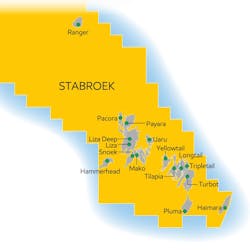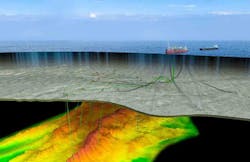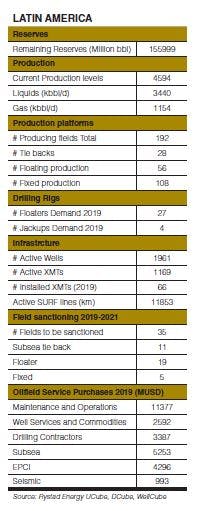Guyana, Brazil leading the way
Since the previous downturn, the emergence of Guyana and the resurgence of Brazil played a major role in the industry’s recovery, especially the FPSO market. The FPSO boom in South America is mainly the result of large investments in deepwater exploration and field development. Between 2015 and 2019, oil and gas companies invested about $8.1 billion in exploration and development activities offshore Guyana, according to Rystad Energy. Before the sudden oil price collapse and the COVID-19 pandemic, the analyst said companies were preparing to spend more than $53 billion in the country’s coveted Stabroek block in the coming decade.
Operator Exxon Mobil Corp. and partners Hess Corp. and CNOOC have discovered more than 8 Bbbl of recoverable oil in the deepwater Stabroek block and brought the country’s first offshore development project onstream on Dec. 20, 2019. According to ExxonMobil, Liza Phase 1 is currently ramping up and will produce up to 120,000 b/d of oil in the coming months, using the FPSO Liza Destiny.
The FPSO Liza Unity, which will be used for Liza Phase 2, is at Keppel Shipyard in Singapore for topsides integration and installation. The FPSO will have a processing capacity of 220,000 b/d of oil, 400 MMcf/d of gas, 250,000 b/d of water injection, and storage capacity of 2 MMbbl of crude oil. It will be spread moored in water depth of about 5,249 ft (1,600 m). ExxonMobil has re-engaged TechnipFMC and Saipem for the second phase’s subsea umbilicals, risers and flowlines (SURF). Production is expected to start by mid-2022.
Front-end engineering design (FEED) is under way for a potential third FPSO, Prosperity, to develop the Payara field in the same block. Pending government approvals and project sanctioning, Payara could start as early as 2023. Both FPSOs are based on SBM Offshore’s Fast4Ward program, a newbuild, multi-purpose hull combined with several standardized topsides modules.
Four drillships in Guyana continue to explore and appraise new resources as well as develop the resources within approved projects, ExxonMobil said. A fifth drillship is expected to be deployed later this year. By 2025, the operator expects at least five FPSOs to be in service on the block producing more than 750,000 b/d.
Other companies have found success in Guyanese waters. Tullow Oil and partners Eco (Atlantic) Oil & Gas and Total’s Jethro and Joe discovery wells on the Orinduik block proved two different oil plays in the Cretaceous and Tertiary intervals. Samples from Jethro-1 and Joe-1 indicate mobile heavy crudes, similar to the commercial heavy crudes found in the North Sea, Gulf of Mexico, the Campos basin offshore Brazil, Venezuela, and Angola, according to Eco.
Offshore Suriname, Apache Corp. and Total’s large Maka Central oil discovery in block 58 proved a working hydrocarbon system in the shallower Upper Cretaceous Campanian interval and the deeper Santonian interval.
John J. Christmann IV, Apache’s CEO and president, said: “Preliminary formation evaluation data indicates the potential for prolific oil wells. Additionally, the size of the stratigraphic feature, as defined by 3D seismic imaging, suggests a substantial resource.”
Drilling is under way of the second exploration well on block 58, Sapakara West-1. Despite the recent downturn, Apache said it will proceed, as planned, to a third exploration prospect.
Petrobras and its partners have sanctioned the second phase of the Mero project in the ultra-deepwater Libra block in the presalt Santos basin offshore Brazil. Designed and constructed using SBM’s Fast4Ward program, the FPSO Sepetiba will have a processing capacity of 180,000 b/d of oil, 12 MMcm/d of gas, 250,000 b/d of water injection, and storage capacity of 1.4 MMbbl of crude oil. Delivery is due in 2022. It will be spread moored in 6,562 ft (2,000 m) water depth and link up to 16 wells. Other partners in the Libra consortium are Shell, CNOOC, and CNPC. Pré-Sal Petróleo manages the Libra production-sharing contract.
Equinor has awarded FEED contracts for the Phase 1 development of the Bacalhau (ex-Carcará) area in the presalt Santos basin offshore Brazil. MODEC, which started pre-FEED work for the FPSO in late 2018, will handle the full FEED, with the Subsea Integration Alliance (SIA) between Subsea 7 and OneSubsea responsible for the SURF FEED.
The contracts are based on a two-step award. FEED and pre-investment are under way, with an option to progress to the execution phase under a lump sum turnkey contract that includes engineering, procurement, construction, and installation for the entire SURF and FPSO scopes. Both are subject to a planned investment decision late in 2020. First oil should follow during 2023-24.
The Bacalhau field is 115 mi (185 km) from the coast of the State of São Paulo in water depths of around 6,726 ft (2,050 m).
According to Equinor, the FPSO will be Brazil’s largest to date with a production capacity of 220,000 b/d.
MODEC will be responsible for the design and construction of the FPSO, including topsides processing equipment, hull and marine systems, with SOFEC supplying the spread-mooring system. This will be the second application of the company’s M350 hull, a newbuild double-hull design said to accommodate larger topsides and larger storage capacity than conventional VLCC tankers, also providing a longer design service life. Dalian Shipbuilding Industry Co. in China will construct the hull.
Margareth Øvrum, Equinor’s executive vice president, Development and Production Brazil, said the company planned to grow its production offshore Brazil to 300-500,000 b/d by 2030.
Equinor operates Bacalhau with a 40% interest, in partnership with ExxonMobil 40%, Petrogal Brasil 20% and Pré-sal Petróleo SA.
Oil companies are advancing exploration and development projects throughout Latin America.
Last summer, Eni became the first international operator to produce oil offshore Mexico following the country’s Energy Reform. Early production started from the Mitzón 2 well on the Miztón field in Area 1 in the Campeche Bay. This was the initial development on the concession which also contains the Amoca and Tecoalli fields: total in-place resources are estimated at 2.1 Bboe (90% oil). The company acquired Area 1 under a competitive bid round in September 2015.
Production from the Miztón field platform, in 111 ft (34 m) water depth, is exported through a multiphase pipeline to Eni’s onshore receiving facility (ORF) in Sanchez Magallanes, State of Tabasco.
Following separation at ORF, the wellstream continues to Pemex’s San Ramón plant for treatment.
Eni expects the early production phase to deliver up to 15,000 b/d of oil with full-field production to begin in early 2021 via an FPSO, building to a peak of 100,000 boe/d.
According to Eni CEO Claudio Descalzi, production began less than two and a half years after the company’s its first well in the concession and in less than a year since the government approved the project.
The plan for Area 1 also includes two additional platforms on the Amoca field and one on the Tecoalli field.
Eni’s Saasken oil discovery in block 10 in the Sureste basin is estimated to have 200-300 MMbbl of oil in-place. The company and partners Lukoil and Capricorn plan to appraise the discovery and initiate studies for a commercial development.
Talos Energy will likely submit the development plan for the offshore Zama field to Mexico’s government this summer, according to partner Premier Oil. Last June, the block 7 joint venture agreed on the main elements of a full-field development to maximize overall recovery from the Zama field, where reserves are thought to be in the range 670-970 MMboe. They propose two processing, drilling and accommodation platforms connected to an FPSO, with oil offtake by tankers.
Premier stressed that approval for the plan would be subject to an agreement on unitization of the field between the block 7 partners and Pemex, operator of an adjacent block containing an extension of Zama. Discussions are progressing in accordance with the Mexican regulatory process. But if no accord is forthcoming, an independent expert will be appointed during 2Q to determine the initial tract participation of the field, in compliance with the government-approved pre-unitization agreement process.
BHP has selected SBM Offshore USA Inc., Technip USA Inc. dba Genesis North America, and McDermott Inc. to deliver an early engineering study for a semisubmersible floating production unit for the deepwater Trion field off Mexico. BHP is the operator and holds 60% interest, and Pemex holds 40%.
Offshore Trinidad and Tobago, BHP has sanctioned the Ruby oil and gas project in block 3 (a). The development will focus on resources in the Ruby and Delaware reservoirs and will involve tiebacks of five production wells to existing processing facilities. BHP estimates recoverable resources at 13.2 MMbbl of oil and 274 bcf of natural gas. It anticipates start-up during the 2021 calendar year, with peak output of ~16,000 b/d and ~80 MMcf/d. Partners are Heritage Petroleum and the National Gas Company of Trinidad and Tobago.
Bahamas Petroleum Co., which has been preparing to drill its first exploratory well offshore the Bahamas, said if current negative developments forced a postponement of Perseverance #1 from the planned spud date in June, the next practical window would be from mid-October onwards. This is after the peak-risk period of the hurricane season in the Gulf of Mexico area. The company stressed that this is not its planning objective, but that it needs to put in place a realistic “back-up” plan to meet its primary license obligation of an initial exploration well in 2020. •
About the Author
Jessica Stump
Editor
Jessica Stump is editor of Offshore Magazine. She uploads and writes news to the website, assembles surveys and electronic newsletters, and writes and edits articles for the magazine. She was the summer editorial intern at Offshore in 2009 and 2010 before joining full time in April 2011. She has a journalism degree from Texas Tech University.




